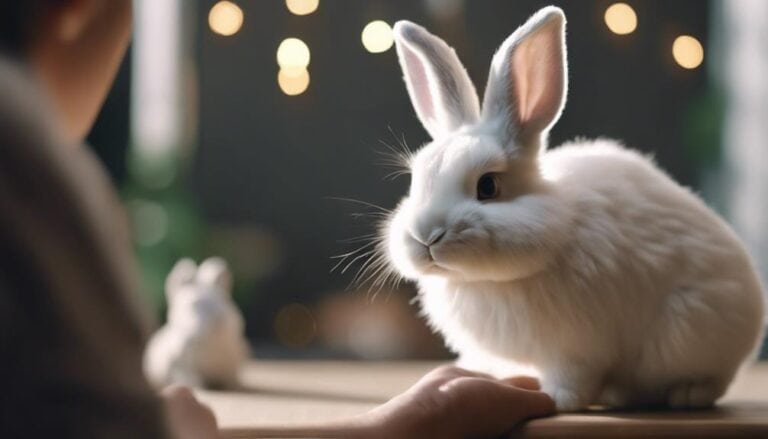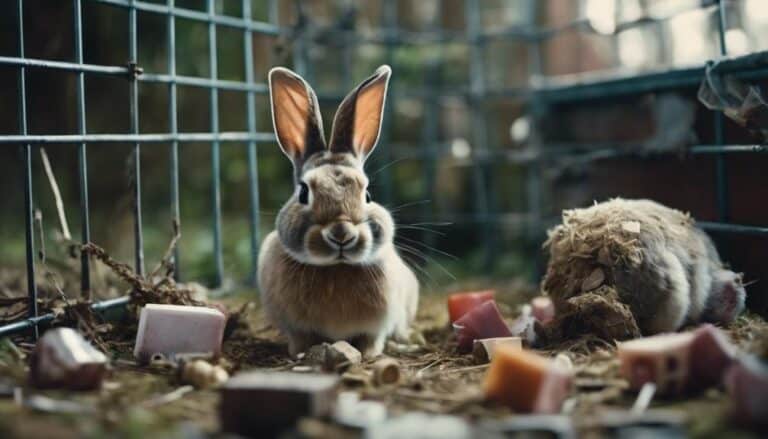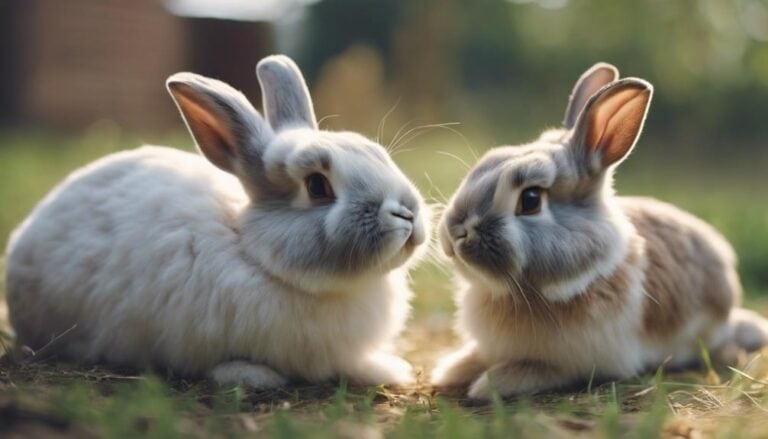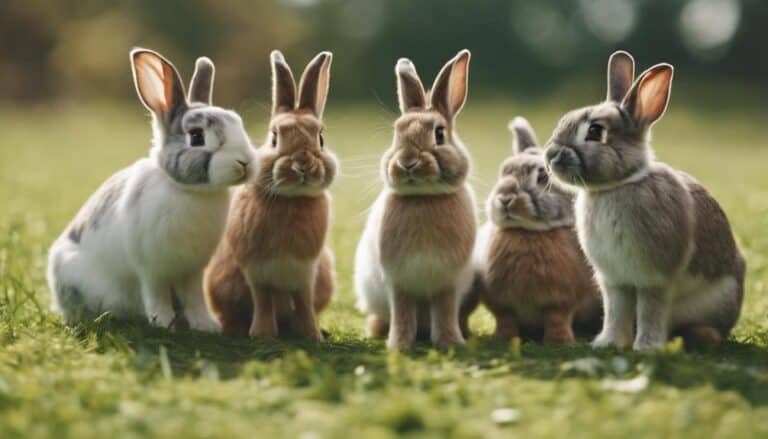When it comes to decoding bunny behavior, you might think you know what your bunny is saying, but have you really grasped the full extent of their silent conversations?
Understanding the subtle nuances of your bunny's actions can reveal a world of insights into their well-being and emotions. From a simple flop to a gentle nudge, each gesture holds a key to strengthening your bond with your furry friend.
So, next time your bunny exhibits a behavior, pay close attention – you might be surprised by what you discover.
Contents
Key Takeaways
- Bunnies communicate joy through binkying and chinning behaviors.
- Behavioral expressions like kicking or nudging convey emotions and needs.
- Digging habits signify territorial establishment and nesting behaviors.
- Understanding bunny behavior enhances bonding, trust, and relationship development.
Binkying or Boinking Behavior
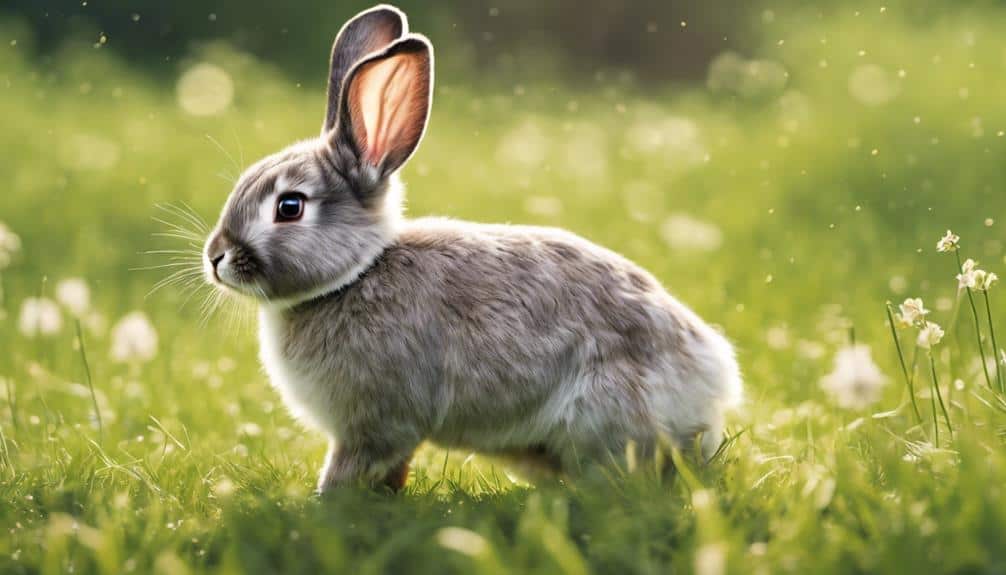
When observing rabbits, the behavior of binkying or boinking can be described as a joyful and exuberant expression of excitement. This behavior involves the rabbit leaping into the air with a sense of joy and enthusiasm. Often accompanied by a running start, boinking is a clear sign of heightened excitement in bunnies. The sight of a rabbit engaging in binkying is a heartwarming display of happiness and contentment. It's a playful gesture that signifies the rabbit's overall well-being and positive state of mind.
Rabbits exhibit binkying when they're feeling particularly happy or content. The sheer delight they experience can be seen in the way they leap and twist in the air, showcasing their exuberance. This behavior is a joyful expression of the rabbit's inner emotions, reflecting a sense of pure joy and enthusiasm. By engaging in binkying, rabbits convey their playful nature and their ability to find happiness in simple moments.
Chinning Communication
When a rabbit engages in chinning behavior, it isn't merely a casual action; it's a deliberate way of marking territory and communicating with other rabbits and their human companions.
By rubbing their chin on various surfaces, rabbits release scent pheromones that convey messages of ownership, comfort, and social bonding.
Understanding the significance of chinning can provide valuable insights into your rabbit's needs and preferences, ultimately helping you nurture a harmonious relationship with your furry friend.
Scent Marking Significance
Chinning serves as an important method of communication for rabbits, allowing them to assert ownership and establish territorial boundaries through scent marking with glands located under their chin. This behavior is deeply rooted in their instinctual need to feel secure in their environment. By leaving their scent through chinning, rabbits create a familiar and reassuring atmosphere around them.
They mark objects, people, or areas to establish ownership, signaling their preferences and boundaries. Understanding this chinning communication is vital for rabbit owners to respect their pets' territorial instincts and provide a conducive living space. Recognizing the significance of scent marking can help create a harmonious environment where rabbits feel safe and secure in their surroundings.
Territory Declaration Method
Through chinning, rabbits assert their ownership and establish territorial boundaries by marking objects with scent glands located under their chin. This behavior, rooted in instinct, serves as a form of communication and territorial declaration.
By rubbing their chin on various surfaces, including furniture legs and items in their environment, rabbits leave behind their scent, signaling to other rabbits the boundaries of their territory. Understanding this behavior is important for rabbit owners to recognize their pet's need for territory and ownership.
Providing appropriate enrichment in their living space, such as objects for chinning, can help satisfy this natural instinct and create a sense of security for the rabbits. By acknowledging and supporting their chinning behavior, owners can make sure their rabbits feel secure and content in their environment.
Social Bonding Indicator
By utilizing their chin's scent glands, rabbits intricately communicate their social bonds through a behavior known as chinning. This chinning behavior serves as a significant social bonding indicator among rabbits. Here's how rabbits use chinning to convey messages:
- Chinning is a way for rabbits to mark their territory, indicating ownership and boundaries.
- Rabbits leave their scent behind through chinning, claiming objects or individuals in their environment.
- Chinning reflects a rabbit's sense of security and comfort, showing their familiarity with the surroundings.
- When a rabbit chin-rubs against you, it signifies affection and a desire to strengthen the bond between you both.
Understanding these chinning cues can help decode a rabbit's social interactions and communication signals effectively.
Digging Habits
When observing your bunny's digging habits, consider the significance of each dig. Rabbits may dig to establish territories, creating defined spaces within their environment.
Nesting behaviors may also prompt rabbits to dig, preparing cozy spots for rest or potential offspring.
Additionally, digging can serve as a means of exploration, allowing rabbits to investigate and navigate their surroundings efficiently.
Digging for Territory
Rabbits exhibit digging behavior primarily to mark their territory using scent glands located on their chin. When your bunny starts digging, pay attention to what they might be trying to communicate:
- Attention: Your rabbit might be digging to seek your attention or interact with you.
- Treats: Digging can also signal a desire for treats or rewards.
- Digging Box: Providing a designated digging area, like a digging box filled with appropriate materials, can help satisfy this natural behavior.
- Behavior Monitoring: Observing and redirecting excessive digging can maintain a peaceful cohabitation, ensuring both you and your rabbit enjoy a harmonious living space.
Digging for Nesting
After establishing their territory through digging behavior, rabbits exhibit a distinct pattern of digging for nesting purposes, a behavior that serves a critical role in their reproductive cycle and overall well-being.
Digging for nesting is an instinctual behavior deeply rooted in a rabbit's natural instincts. Pregnant rabbits, in particular, engage in extensive digging activities as they prepare for giving birth. Providing a suitable digging area with the right materials is vital for their comfort during this time.
Digging for Exploration
Engaging in frequent digging activities, rabbits display a natural tendency for exploration and mental stimulation, which are essential aspects of their behavioral repertoire. When observing your bunny's digging behavior, consider these key points:
- Mental Stimulation: Digging provides rabbits with mental exercise, keeping their minds active and engaged.
- Physical Exercise: Through digging, rabbits also get the physical activity they need to stay healthy and agile.
- Digging Box: Providing a designated digging area filled with safe materials like hay or shredded paper can redirect their digging instincts.
- Monitoring Preferences: By observing your rabbit's digging habits, you can learn about their preferences and tailor their environment to enrich their digging experiences.
Flopping Signals
When a bunny flops onto its side, it signifies a state of contentment and relaxation, revealing a deep sense of trust and security within its environment. This behavior is a clear indication that your bunny is feeling safe, comfortable, and happy in its surroundings.
By observing your bunny flopping, you can gain valuable insights into their emotional state and well-being. Whether during playtime, grooming sessions, or simply resting, flopping is a positive signal that your bunny is at ease.
It shows that your rabbit trusts its environment enough to fully relax and let go of any stress or tension. Understanding this behavior can help you make sure that your bunny feels secure and content in its home.
Kicking Up Feet Gestures
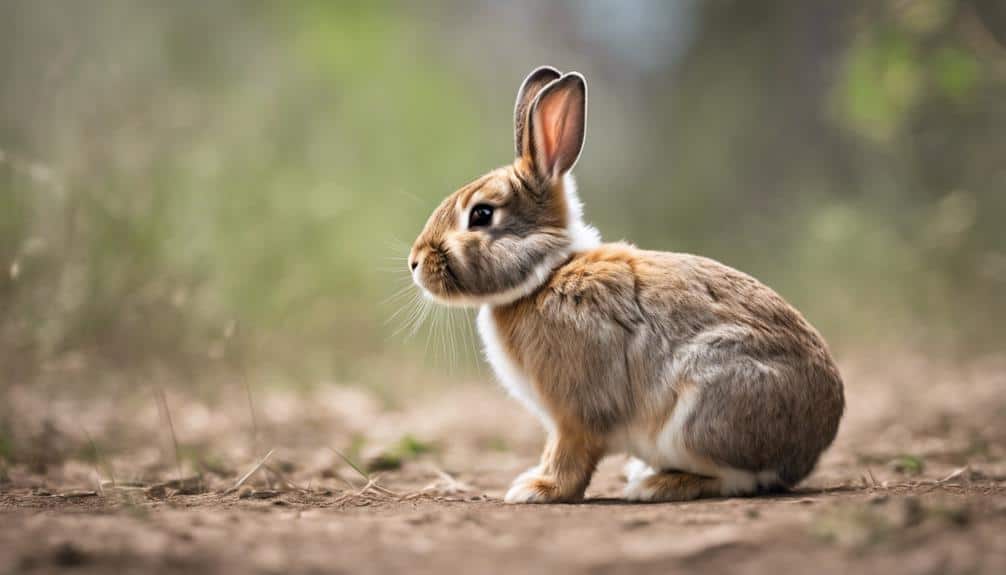
Observing a rabbit kicking up its feet while hopping away reveals signals of displeasure or frustration in their emotional state. This behavior can indicate annoyance or a need for space, as rabbits may kick their feet when feeling scared or uncomfortable. Essential to pay attention to the context of kicking up feet gestures to gain insight into your bunny's emotions. By understanding these signals, you can improve communication and strengthen the bond with your rabbit.
- Displeasure and Frustration: When a rabbit kicks up its feet, it may be expressing feelings of displeasure or frustration.
- Annoyance and Need for Space: This behavior can signify that the rabbit is annoyed or requires some personal space.
- Scared or Uncomfortable: Rabbits may kick their feet when they're scared or feeling uncomfortable in a particular situation.
- Emotional Communication: Kicking up feet gestures serve as a form of emotional communication, allowing rabbits to express their feelings non-verbally.
Licking Expressions
After observing a rabbit's kicking up feet gestures to understand its emotional state, let's now explore the fascinating world of licking expressions in rabbit behavior. Rabbits use licking not only as a grooming behavior but also as a way to bond with others.
When rabbits lick objects, they may be marking their territory by spreading their scent. This behavior isn't limited to objects; rabbits often lick their owners as a sign of affection and comfort. Understanding your rabbit's licking behavior can help you strengthen the bond you share.
Each rabbit may have preferences for textures or flavors when licking objects, so pay attention to what they enjoy. By acknowledging and reciprocating this behavior, you can further deepen your connection with your furry friend.
Nudging and Nipping Actions
Nudging is a common and significant behavior exhibited by rabbits to convey various messages, such as seeking attention, affection, or communicating specific needs. When interpreting a rabbit's behavior, it's important to understand the nuances of nudging and nipping actions. Here's what you need to know:
- Attention and Affection: Rabbits may nudge gently to seek attention or express their desire for affection. This soft nudge typically signifies a friendly interaction.
- Communication and Boundaries: Nudging can also serve as a way for rabbits to communicate their needs or establish boundaries. They may nudge to indicate a desire to be petted or moved aside.
- Warning Signs: On the other hand, a hard nudge or a nipping behavior can signal a warning. Rabbits may use these actions to express discomfort or to alert you to potential dangers.
- Escalation of Communication: Nudging followed by nipping can be a way for rabbits to escalate their communication if their initial nudging is ignored. Understanding the difference between these actions is key to interpreting your rabbit's intentions accurately.
Frequently Asked Questions
How Do You Know What Your Bunny Is Saying?
You understand your bunny's feelings by observing body language, vocal cues, social interactions, playtime behaviors, eating habits, grooming rituals, sleeping patterns, aggression signs, bonding activities, and environmental responses. This knowledge helps you decode your bunny's messages effectively.
How Does My Rabbit Say I Love You?
Your rabbit says "I love you" through bunny kisses, nuzzling behavior, loving hops, snuggle sessions, playful antics, gentle nudges, happy binkies, content grooming, trust building, and cuddling closeness. These actions demonstrate their affection and bond with you.
What Do Rabbits Actions Mean?
When your rabbit chews constantly, it may indicate dental issues or dietary deficiencies. Observe their eating habits closely for any changes. Pay attention to their social interactions; rabbits are social animals and thrive on companionship.
What Is the Rabbit Trying to Tell Me?
When your bunny communicates, pay attention to body language, vocal cues, social interactions, eating habits, grooming rituals, playtime behavior, sleeping patterns, aggressive tendencies, bonding activities, and territorial behavior. Understanding these signals strengthens your bond.
How Does a Bunny’s Behavior Differ Between Mini Lop and Holland Lop Breeds?
When comparing mini lop vs Holland Lop bunny behavior, there are some differences to consider. Mini lops are known for being more playful and energetic, while Holland Lops tend to be more independent and laid-back. Mini lops may require more attention and social interaction, while Holland Lops are content to entertain themselves.
Conclusion
In summary, deciphering your bunny's behavior is akin to unraveling a complex code of non-verbal cues. By observing their binkying, chinning, digging, flopping, kicking up feet, licking, nudging, and nipping, you can gain valuable insights into their emotions and needs.
Just as a skilled cryptographer deciphers hidden messages, decoding your bunny's actions will reveal a deeper bond and understanding between you and your furry companion. Happy decoding!


